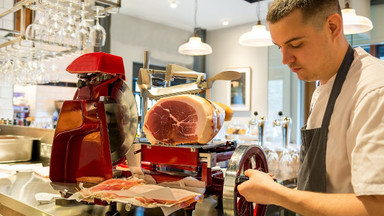Jun 19th 2020
How to Choose the Best Commercial Meat Slicer
A deli will obviously spend more minutes per day slicing meat than a soup bar. Some food operations need a slicer that can cut both meat and cheese while others need a slicer only for special menu items they make only occasionally. Thinking about what your menu demands and how many customers you feed daily are factors in how to choose the best commercial meat slicer.
Volume
Meat slicers come in light-, medium-, and heavy-duty versions. It’s unlikely that a bakery needs a lot of sliced meat, but there are the occasional menu items that incorporate something for the carnivores among us. Some bakery and café items also cater to the gooey-cheese crowd, which may require different thicknesses of sliced cheese. While a light-duty slicer can cut vegetables, it can’t handle frozen items. This type of slicer is for shops that use them less than an hour a day.
On the other end of the spectrum are shops that use a meat slicer constantly, like grocery deli counters and sandwich shops. These will need a premium, heavy-duty model that can withstand constant use and can handle frozen items.
If you’ll be cutting uncooked meat, your safest bet may be to maintain two separate slicers—one for raw and one for cooked items—to ensure no cross-contamination could sicken your customers.
Features
This is where choosing a commercial meat slicer can turn into a deep dive down the hasenpfeffer hole. All slicers should be easy to clean and sanitize and should have safety features like a no-voltage release. If the power goes out for any reason while the slicer is running, the no-voltage release ensures that the slicer won’t just turn on again as soon as the power comes on.
Some slicers feature automatic carriages, which move on their own while you push the meat against the blade. Others are manual, requiring the user to move the carriage themselves. Very busy operations that use a lot of sliced meat may need the automatic version, while others prefer the control of a manual machine. Also, consider if you only need traditional slices of different thicknesses, or if you need a meat cutting machine that can produce strips of meat for specialty recipes.
Slicer power, or how fast a machine can slice for how long, is measured in horsepower. The higher the horsepower, the heavier-duty the machine. Volume also dictates the size of the blade you will choose. Large blades can measure as much as 14 inches or as small as 8. Choose a stainless steel blade for best performance, durability, and easy cleaning.
Machines with pushers angled to take advantage of gravity require less muscle power to keep the product against the blade. Some slicers sharpen themselves or come with built-in sharpeners. Also, think about the size of the chunks of meat you will be slicing—the carriage on the slicer has to be big enough to accommodate the size of your slabs of meat.
Pro Restaurant Equipment offers a variety of commerical meat cutting machines and can help you choose the best commercial meat slicer for your needs.

